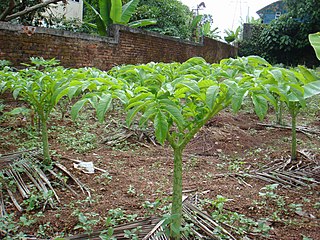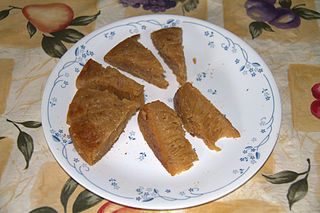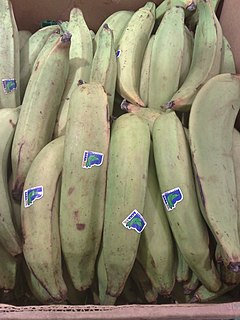
Cooking bananas are banana cultivars in the genus Musa whose fruits are generally used in cooking. They may be eaten ripe or unripe and are generally starchy. Many cooking bananas are referred to as plantains or green bananas, although not all of them are true plantains. Bananas are treated as a starchy fruit with a relatively neutral flavour and soft texture when cooked. Bananas fruit all year round, making them a reliable all-season staple food.

Puerto Rican cuisine has its roots in the cooking traditions and practices of Europe, Africa and the native Taínos. Starting from the latter part of the 19th century, the cuisine of Puerto Rico has been greatly influenced by the United States in the ingredients used in its preparation. Puerto Rican cuisine can be found in several other countries.

Malaysian cuisine consists of cooking traditions and practices found in Malaysia, and reflects the multiethnic makeup of its population. The vast majority of Malaysia's population can roughly be divided among three major ethnic groups: Malays, Chinese and Indians. The remainder consists of the indigenous peoples of Sabah and Sarawak in East Malaysia, the Orang Asli of Peninsular Malaysia, the Peranakan and Eurasian creole communities, as well as a significant number of foreign workers and expatriates.

Upma, uppumavu or uppittu is a dish originating from the Indian subcontinent, most common in South Indian, Maharashtrian, and Sri Lankan Tamil breakfast, cooked as a thick porridge from dry-roasted semolina or coarse rice flour. Various seasonings and/or vegetables are often added during the cooking, depending on individual preferences. Today it is popular in most parts of India and is prepared in various ways.

Tamil cuisine is a cuisine native to the Tamil people who are native to the Indian state of Tamil Nadu and northern Sri Lanka. It is also the cuisine of the Tamil-speaking population of Karnataka, Kerala and Andhra Pradesh in India and of the Tamil communities of Singapore, Malaysia, and Indonesia.

The cuisine of Karnataka includes many vegetarian and non-vegetarian cuisines. It is one of the oldest surviving cuisines and traces its origin to the Iron Age. Ragi is mentioned in the historical works of the great poet Adikavi Pampa and in the ancient Sanskrit medical text Sushruta Samhita. The varieties of the Karnataka cuisine have drawn influence from and influenced the cuisines of neighbouring states like Tamil Nadu, Andhra Pradesh and Kerala. Although the ingredients differ from one region to another, a typical Kannadiga Oota includes the following dishes in the order specified and is served on a banana leaf: Uppu (salt), Kosambari, Pickle, Palya, Gojju, Raita, Payasa (Kheer), Thovve, Chitranna, Anna (rice), and Tuppa (ghee).

Peranakan cuisine or Nyonya cuisine comes from the Peranakans, descendants of early Chinese migrants who settled in Penang, Malacca, Singapore and Indonesia inter-marrying with local Malays and combines Chinese, Malay and other influences. The old Malay word nonya, a term of respect and affection for women of prominent social standing, has come to refer to the cuisine of the Peranakans.

Undhiyu is a Gujarati mixed vegetable dish that is a regional specialty of Surat, India. The name of this dish comes from the Gujarati word "undhu", which translates to upside down, since the dish is traditionally cooked upside down underground in earthen pots, termed "matlu", which are fired from above.

Thoran is a coconut-based vegetable dish in Kerala. This common dish is usually eaten with steamed rice. Thoran is a common menu item for a sadhya.
Pachadi refers to a traditional South Indian fresh pickle served as a side dish. Broadly translated, it refers to food which has been pounded. In Karnataka, Kerala and Tamil Nadu, pachadi is a side dish curry similar to the North Indian raita, and is made with vegetable, yoghurt, coconut, ginger and curry leaves and seasoned with mustard. Pachadi generally is a mildly spiced coconut and yogurt-based dish made with seasonal vegetables or fruits.

Lontong is a Southeast Asian dish made of compressed rice cake in the form of a cylinder wrapped inside a banana leaf, commonly found in Indonesia; also to lesser extent in Malaysia and Singapore. The rice rolled inside banana leaf and boiled, then cut into small cakes as staple food replacement of steamed rice. The texture is similar to those of ketupat, with the difference that ketupat container was made from weaved janur fronds, while lontong uses banana leaf instead.

[[File:Yam pottage.jpg|thumb|A yam porridge
Ajethna or Ajadina is a dry gravyless vegetable curry. Ajadina means dried in the Tulu language. The ajethna is eaten along with plain cooked rice as part of Udupi cuisine. The vegetables generally used in ajethna are cluster beans, french beans, beetroot, snake gourd, bitter gourd, ladies finger, and others.

Sundanese cuisine is the cuisine of the Sundanese people of West Java, Indonesia. It is one of the most popular foods in Indonesia. Sundanese food is characterised by its freshness; the famous lalab eaten with sambal and also karedok demonstrate the Sundanese fondness for fresh raw vegetables. Unlike the rich and spicy taste, infused with coconut milk and curry of Minangkabau cuisine, the Sundanese cuisine displays the simple and clear taste; ranged from savoury salty, fresh sourness, mild sweetness, to hot and spicy.
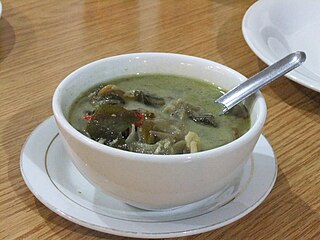
Sayur lodeh is a Southeast Asian vegetable soup prepared from vegetables in coconut milk popular in Indonesia, but most often associated with Javanese cuisine.

Telugu cuisine is a cuisine of South India native to the Telugu people from the states of Andhra Pradesh and Telangana. Generally known for its tangy, hot and spicy taste, the cooking is very diverse due to the vast spread of the people and varied topological regions.
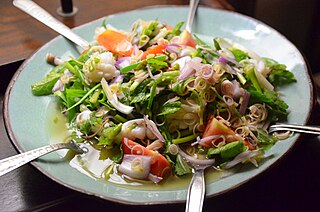
Salads that are internationally known as Thai salads, with a few exceptions, fall into four main methods of preparation. In Thai cuisine these are called yam, tam, lap and phla. A few additional dishes can also be regarded as being a salad.
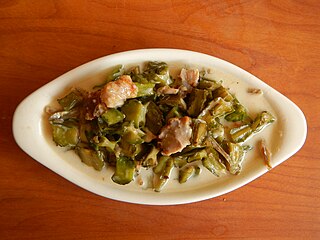
Gising-gising, also known as ginataang sigarilyas, is a spicy Filipino vegetable soup or stew originating from the provinces of Nueva Ecija and Pampanga in the Philippines. It is traditionally made with chopped winged beans, and coconut milk spiced with labuyo chili, garlic, onions, and bagoong alamang. The name literally means "wake up, wake up". It can be eaten alone, on top of rice, or as a side dish to grilled meat dishes. It is a type of ginataan.




